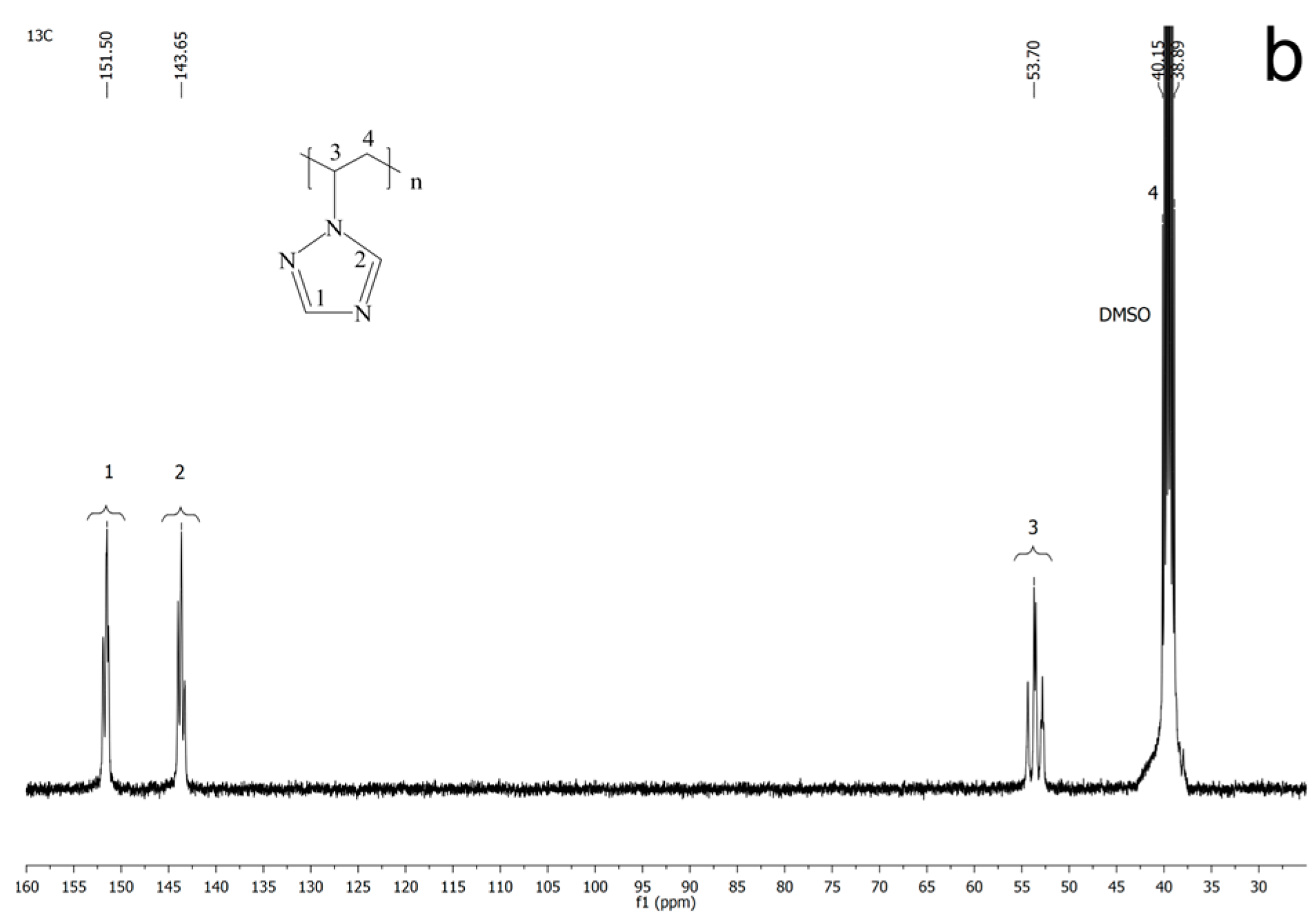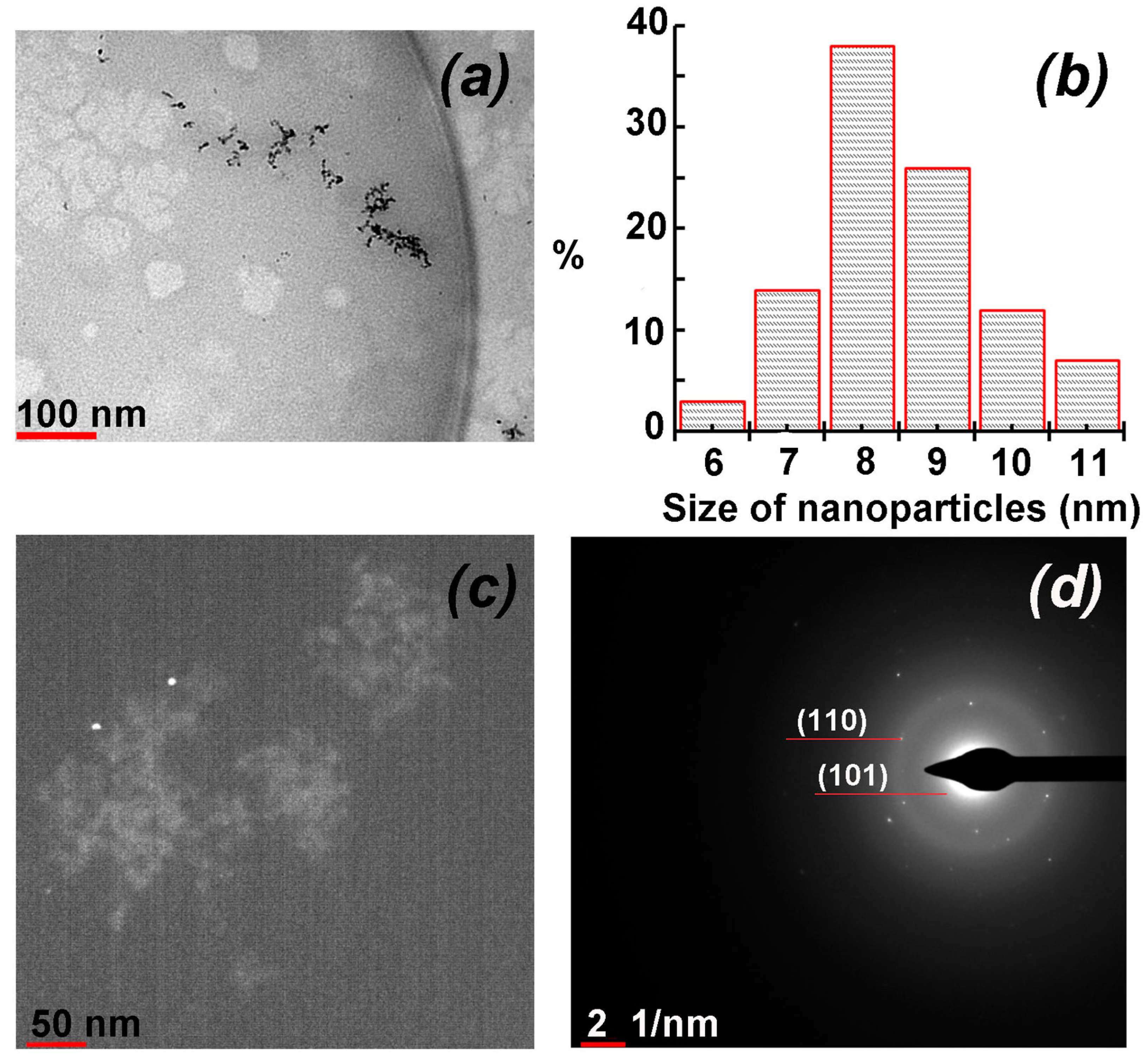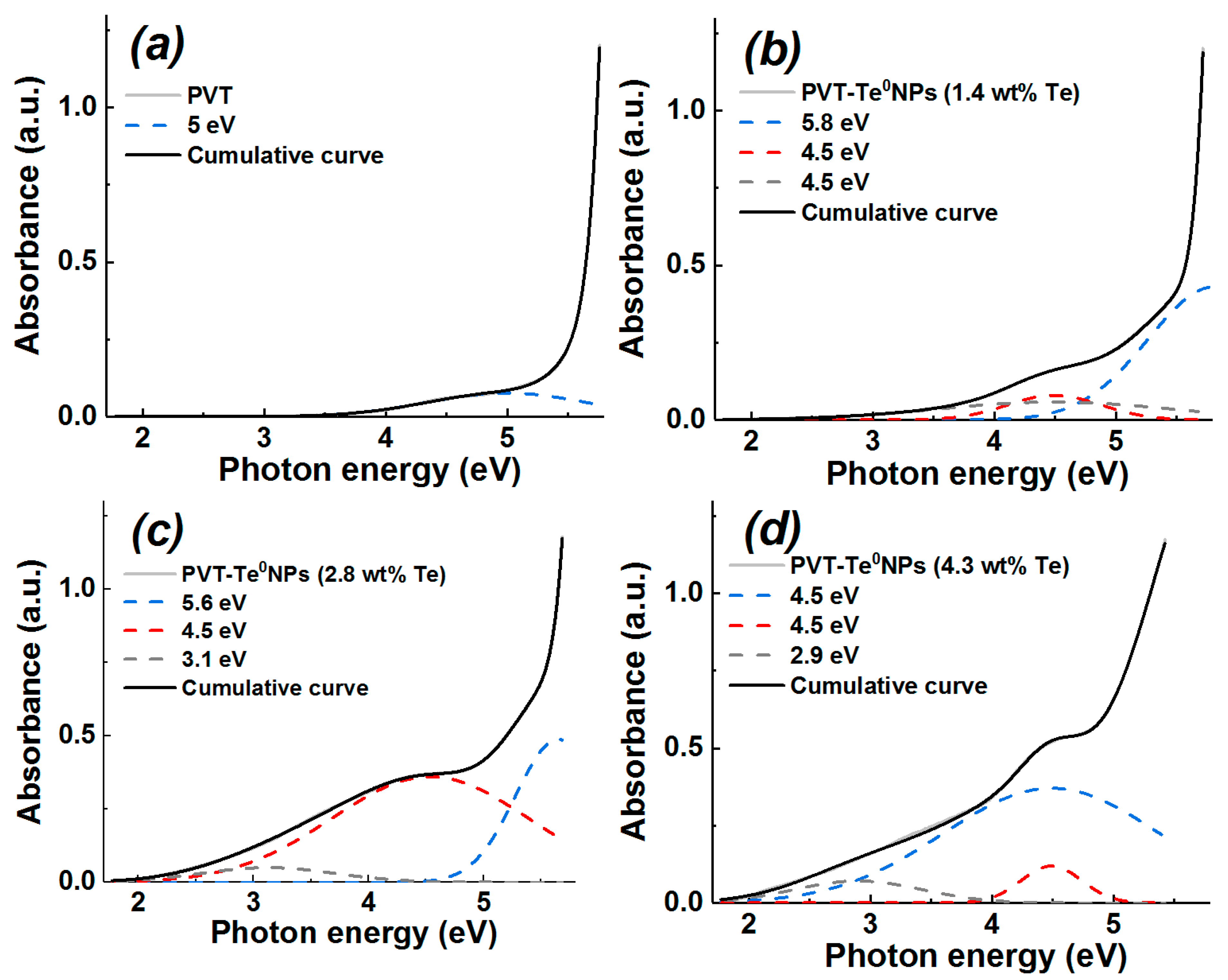Synthesis and DC Electrical Conductivity of Nanocomposites Based on Poly(1-vinyl-1,2,4-triazole) and Thermoelectric Tellurium Nanoparticles
Abstract
1. Introduction
2. Materials and Methods
2.1. Materials
2.2. Methods
2.2.1. Synthesis of PVT
2.2.2. Synthesis of PVT–Te0NPs
2.3. Equipment
2.3.1. Elemental Analysis (EA)
2.3.2. X-ray Diffraction (XRD) Analysis
2.3.3. UV-Vis Spectroscopy
2.3.4. Dynamic Light Scattering (DLS)
2.3.5. Gel Permeation Chromatography
2.3.6. Nuclear Magnetic Resonance
2.3.7. High Resolution–Transmission Electron Microscopy (HR-TEM)
2.3.8. Direct Current Electrical Conductivity Measurement
3. Results and Discussion
3.1. Synthesis of PVT–Te0NPs
3.2. XRD Analysis
3.3. HR-TEM Analysis
3.4. Dynamic Light Scattering Analysis
3.5. UV-Vis Spectroscopy
3.6. DC Electrical Conductivity
4. Conclusions
Author Contributions
Funding
Institutional Review Board Statement
Informed Consent Statement
Data Availability Statement
Acknowledgments
Conflicts of Interest
References
- Kwan, T.H.; Wu, X.; Yao, Q. Complete implementation of the combined TEG-TEC temperature control and energy harvesting system. Control Eng. Pract. 2020, 95, 104224. [Google Scholar] [CrossRef]
- Pan, S.; Wang, T.; Jin, K.; Cai, X. Understanding and designing metal matrix nanocomposites with high electrical conductivity: A review. J. Mater. Sci. 2022, 57, 6487–6523. [Google Scholar] [CrossRef]
- Li, J.; Huckleby, A.B.; Zhang, M. Polymer-based thermoelectric materials: A review of power factor improving strategies. J. Mater. 2022, 8, 204–220. [Google Scholar] [CrossRef]
- Zhou, C.; Dun, C.; Ge, B.; Wang, K.; Shi, Z.; Liu, G.; Carroll, D.L.; Qiao, G. Highly robust and flexible n-type thermoelectric film based on Ag2Te nanoshuttle/polyvinylidene fluoride hybrids. Nanoscale 2018, 10, 14830–14834. [Google Scholar] [CrossRef] [PubMed]
- Zhao, X.; Han, W.; Jiang, Y.; Zhao, C.; Ji, X.; Kong, F.; Xu, W.; Zhang, X. A honeycomb-like paper-based thermoelectric generator based on a Bi2Te3/bacterial cellulose nanofiber coating. Nanoscale 2019, 11, 17725–17735. [Google Scholar] [CrossRef] [PubMed]
- Kim, S.; Ryu, S.H.; Kwon, Y.-T.; Lim, H.-R.; Park, K.-R.; Song, Y.; Choa, Y.-H. Synthesis and thermoelectric characterization of high density Ag2Te nanowire / PMMA nanocomposites. Mater. Chem. Phys. 2017, 190, 187–193. [Google Scholar] [CrossRef]
- Andzane, J.; Buks, K.; Bitenieks, J.; Bugovecka, L.; Kons, A.; Merijs-Meri, R.; Svirksts, J.; Zicans, J.; Erts, D. p-Type PVA/MWCNT-Sb2Te3 Composites for Application in Different Types of Flexible Thermoelectric Generators in Combination with n-Type PVA/MWCNT-Bi2Se3 Composites. Polymers 2022, 14, 5130. [Google Scholar] [CrossRef]
- Morad, M.; Fadlallah, M.M.; Hassan, M.A.; Sheha, E. Evaluation of the effect of V2O5 on the electrical and thermoelectric properties of poly (vinyl alcohol)/graphene nanoplatelets nanocomposite. Mater. Res. Express 2016, 3, 035015. [Google Scholar] [CrossRef]
- Wang, J.; Du, Y.; Qin, J.; Wang, L.; Meng, Q.; Li, Z.; Shen, S.Z. Flexible Thermoelectric Reduced Graphene Oxide/Ag2S/Methyl Cellulose Composite Film Prepared by Screen Printing Process. Polymers 2022, 14, 5437. [Google Scholar] [CrossRef]
- Dun, C.; Hewitt, C.A.; Huang, H.; Montgomery, D.S.; Xu, J.; Carroll, D.L. Flexible thermoelectric fabrics based on self-assembled tellurium nanorods with a large power factor. Phys. Chem. Chem. Phys. 2015, 17, 8591–8595. [Google Scholar] [CrossRef]
- Pammi, S.V.N.; Jella, V.; Choi, J.S.; Yoon, S.G. Enhanced thermoelectric properties of flexible Cu2−xSe (x ≥ 0.25) NW/polyvinylidene fluoride composite films fabricated via simple mechanical pressing. J. Mater. Chem. C 2017, 5, 763–769. [Google Scholar] [CrossRef]
- Oopathump, C.; Boonthuma, D.; Smith, S.M. Effect of Poly (Vinyl Alcohol) on thermoelectric properties of sodium cobalt oxide. In Key Engineering Materials. Key Eng. Mater. 2019, 798, 304–309. [Google Scholar] [CrossRef]
- Jiang, C.; Wei, P.; Ding, Y.; Cai, K.; Tong, L.; Gao, Q.; Lu, Y.; Zhao, W.; Chen, S. Ultrahigh performance polyvinylpyrrolidone/Ag2Se composite thermoelectric film for flexible energy harvesting. Nano Energy 2021, 80, 105488. [Google Scholar] [CrossRef]
- Kim, S.; Lee, Y.-I.; Ryu, S.H.; Hwang, T.-Y.; Song, Y.; Seo, S.; Yoo, B.; Lim, J.-H.; Cho, H.-B.; Myung, N.V.; et al. Synthesis and thermoelectric characterization of bulk-type tellurium nanowire/polymer nanocomposites. J. Mater. Sci. 2017, 52, 12724–12733. [Google Scholar] [CrossRef]
- Li, X.; Du, Y.; Meng, Q. Flexible ball-milled Bi0.4Sb1.6Te3/methyl cellulose thermoelectric films fabricated by screen-printing method. Funct. Mater. Lett. 2021, 14, 2151034. [Google Scholar] [CrossRef]
- Dun, C.; Hewitt, C.A.; Huang, H.; Hu, J.; Montgomery, D.S.; Nie, W.; Jiang, Q.; Carroll, D.L. Layered Bi2Se3 nanoplate/polyvinylidene fluoride composite based n-type thermoelectric fabrics. ACS Appl. Mater. Inter. 2015, 7, 7054–7059. [Google Scholar] [CrossRef]
- Bitenieks, J.; Buks, K.; Merijs-Meri, R.; Andzane, J.; Ivanova, T.; Bugovecka, L.; Voikiva, V.; Zicans, J.; Erts, D. Flexible N-Type Thermoelectric Composites Based on Non-Conductive Polymer with Innovative Bi2Se3-CNT Hybrid Nanostructured Filler. Polymers 2021, 13, 4264. [Google Scholar] [CrossRef]
- Qin, J.; Du, Y.; Meng, Q.; Ke, Q. Flexible thermoelectric Cu–Se nanowire/methyl cellulose composite films prepared via screen printing technology. Compos. Commun. 2023, 38, 101467. [Google Scholar] [CrossRef]
- Lesnichaya, M.V.; Zhmurova, A.V.; Sapozhnikov, A.N. Synthesis and Characterization of Water-Soluble Arabinogalactan-Stabilized Bismuth Telluride Nanoparticles. Russ. J. Gen. Chem. 2021, 91, 1379–1386. [Google Scholar] [CrossRef]
- Zvereva, M.V.; Zhmurova, A.V. Synthesis, structure, and spectral properties of ZnTe-containing nanocomposites based on arabinogalactan. Russ. J. Gen. Chem. 2022, 92, 1995–2004. [Google Scholar] [CrossRef]
- Pozdnyakov, A.; Emel’yanov, A.; Kuznetsova, N.; Ermakova, T.; Bolgova, Y.; Trofimova, O.; Albanov, A.; Borodina, T.; Smirnov, V.; Prozorova, G. A Polymer Nanocomposite with CuNP Stabilized by 1-Vinyl-1,2,4-Triazole and Acrylonitrile Copolymer. Synlett 2015, 27, 900–904. [Google Scholar] [CrossRef]
- Zezin, A.; Danelyan, G.; Emel’yanov, A.; Zharikov, A.; Prozorova, G.; Zezina, E.; Korzhova, S.; Fadeeva, T.; Abramchuk, S.; Shmakova, N.; et al. Synthesis of Antibacterial Polymer Metal Hybrids in Irradiated Poly-1-vinyl-1,2,4-triazole Complexes with Silver Ions: PH Tuning of Nanoparticle Sizes. Appl. Organomet. Chem. 2022, 36, e6581. [Google Scholar] [CrossRef]
- Pozdnyakov, A.; Emel’yanov, A.; Ivanova, A.; Kuznetsova, N.; Semenova, T.; Bolgova, Y.; Korzhova, S.; Trofimova, O.; Fadeeva, T.; Prozorova, G. Strong Antimicrobial Activity of Highly Stable Nanocomposite Containing AgNPs Based on Water-Soluble Triazole-Sulfonate Copolymer. Pharmaceutics 2022, 14, 206. [Google Scholar] [CrossRef] [PubMed]
- Prozorova, G.F.; Pozdnyakov, A.S. Synthesis, Properties, and Biological Activity of Poly(1-vinyl-1,2,4-triazole) and Silver Nanocomposites Based on It. Polym. Sci. Ser. C 2022, 64, 62–72. [Google Scholar] [CrossRef]
- Li, C.; Jiang, F.; Liu, C.; Wang, W.; Li, X.; Wang, T.; Xu, J. A simple thermoelectric device based on inorganic/organic composite thin film for energy harvesting. Chem. Eng. J. 2017, 320, 201–210. [Google Scholar] [CrossRef]
- Lin, S.; Li, W.; Chen, Z.; Shen, J.; Ge, B.; Pei, Y. Tellurium as a high-performance elemental thermoelectric. Nat. Commun. 2016, 7, 10287. [Google Scholar] [CrossRef]
- Blackburn, J.L.; Ferguson, A.J.; Cho, C.; Grunlan, J.C. Thermoelectric materials: Carbon-nanotube-based thermoelectric materials and devices. Adv. Mater. 2018, 30, 1870072. [Google Scholar] [CrossRef]
- Fan, Z.; Zhang, Y.; Pan, L.; Ouyang, J.; Zhang, Q. Recent developments in flexible thermoelectrics: From materials to devices. Renew. Sustain. Energy Rev. 2021, 137, 110448. [Google Scholar] [CrossRef]
- Lesnichaya, M.V.; Tsivileva, O.M. Arabinogalactan-Stabilized Selenium Sulfide Nanoparticles and Their Fungistatic Activity Against Phytophthora cactorum. J. Clust. Sci. 2022, 1–12. [Google Scholar] [CrossRef]
- Hu, H.; Zeng, Y.; Gao, S.; Wang, R.; Zhao, J.; You, K.; Song, Y.; Xiao, Q.; Cao, R.; Li, J.; et al. Fast solution method to prepare hexagonal tellurium nanosheets for optoelectronic and ultrafast photonic applications. J. Mater. Chem. C 2021, 9, 508–516. [Google Scholar] [CrossRef]
- Liu, C.; Wang, R.; Zhang, Y. Tellurium Nanotubes and Chemical Analogues from Preparation to Applications: A Minor Review. Nanomaterials 2022, 12, 2151. [Google Scholar] [CrossRef]
- Lu, Q.; Gao, F.; Komarneni, S. Biomolecule-Assisted Reduction in the Synthesis of Single-Crystalline Tellurium Nanowires. Adv. Mater. 2004, 16, 1629–1632. [Google Scholar] [CrossRef]
- Ioffe, B.V.; Kostikov, R.R.; Razin, V.V. Physical Methods for Determining the Structure of Organic Molecules; Leningrad University Press: Leningrad, USSR, 1976. [Google Scholar]
- Rosales-Conrado, N.; Gómez-Gómez, B.; Matías-Soler, J.; Pérez-Corona, M.T.; Madrid-Albarrán, Y. Comparative study of tea varieties for green synthesis of tellurium-based nanoparticles. Microchem. J. 2021, 169, 106511. [Google Scholar] [CrossRef]
- Zambonino, M.C.; Quizhpe, E.M.; Jaramillo, F.E.; Rahman, A.; Vispo, N.S.; Jeffryes, C.; Dahoumane, S.A. Green synthesis of selenium and tellurium nanoparticles: Current trends, biological properties and biomedical applications. Int. J. Mol. Sci. 2021, 22, 989. [Google Scholar] [CrossRef] [PubMed]
- Qian, H.-S.; Yu, S.-H.; Gong, J.-Y.; Luo, L.-B.; Fei, L.-F. High-quality luminescent tellurium nanowires of several nanometers in diameter and high aspect ratio synthesized by a poly (vinyl pyrrolidone)-assisted hydrothermal process. Langmuir 2006, 22, 3830–3835. [Google Scholar] [CrossRef]
- Wallace, A.M.; Curiac, C.; Delcamp, J.H.; Fortenberry, R.C. Accurate determination of the onset wavelength (λonset) in optical spectroscopy. J. Quant. Spectrosc. Radiat. Transf. 2021, 265, 107544. [Google Scholar] [CrossRef]
- Tauc, J.; Grigorovici, R.; Vancu, A. Optical properties and electronic structure of amorphous germanium. Phys. Stat. Sol. 1966, 15, 627–637. [Google Scholar] [CrossRef]
- Davis, E.A.; Mott, N.F. Conduction in non-crystalline systems V. Conductivity, optical absorption and photoconductivity in amorphous semiconductors. Philos. Mag. 1970, 22, 0903–0922. [Google Scholar] [CrossRef]
- Madelung, O. (Ed.) Elements. In Semiconductors: Other than Group IV Elements and III–V Compounds; Springer: Berlin, Germany, 1992; pp. 4–7. [Google Scholar] [CrossRef]
- De Mello Donega, C. Nanoparticles: Workhorses of Nanoscience; Springer: Berlin, Germany, 2014. [Google Scholar]
- Singh, S.C.; Mishra, S.K.; Srivastava, R.K.; Gopal, R. Optical properties of Selenium quantum dots produced with laser irradiation of water suspended Sc nanoparticles. J. Phys. Chem. C. 2010, 114, 17374–17384. [Google Scholar] [CrossRef]
- Ghobadi, N.; Khazaie, F. Fundamental role of the pH on the nanoparticle size and optical band gap in cobalt selenide nanostructure films. Opt. Quant. Electron. 2016, 48, 165. [Google Scholar] [CrossRef]
- Borah, J.P.; Barman, J.; Sarma, K.C. Structural and optical properties of ZnS nanoparticles. Chalcogenide Lett. 2008, 5, 201–208. [Google Scholar]
- Pesika, N.S.; Stebe, K.J.; Searson, P.C. Relationship between absorbance spectra and particle size distributions for quantum-sized nanocrystals. J. Phys. Chem. B. 2003, 107, 10412–10415. [Google Scholar] [CrossRef]
- Prokhorov, A.M. (Ed.) Physical Encyclopedic Dictionary; Soviet Encyclopedia: Moscow, USSR, 1983. [Google Scholar]
- Ansari, M.M.N.; Khan, S. Structural, electrical and optical properties of sol-gel synthesized cobalt substituted MnFe2O4 nanoparticles. Physica B. 2017, 520, 21–27. [Google Scholar] [CrossRef]
- Mehraj, S.; Ansari, M.S.; Al-Ghamdi, A.A. Annealing dependent oxygen vacancies in SnO2 nanoparticles: Structural, electrical and their ferromagnetic behavior. Mater. Chem. Phys. 2016, 171, 109–118. [Google Scholar] [CrossRef]
- Sinha, S.; Chatterjee, S.K.; Ghosh, J.; Meikap, A.K. Electrical transport properties of polyvinyl alcohol–selenium nanocomposite films at and above room temperature. J. Mater. Sci. 2015, 50, 1632–1645. [Google Scholar] [CrossRef]
- Agool, I.R.; Kadhim, K.J.; Hashim, A. Preparation of (polyvinyl alcohol–polyethylene glycol–polyvinyl pyrrolidinone–titanium oxide nanoparticles) nanocomposites: Electrical properties for energy storage and release. Int. J. Plast. Technol. 2016, 20, 121–127. [Google Scholar] [CrossRef]
- Xia, X.; Weng, G.J.; Zhang, J.; Li, Y. The effect of temperature and graphene concentration on the electrical conductivity and dielectric permittivity of graphene–polymer nanocomposites. Acta Mech. 2020, 231, 1305–1320. [Google Scholar] [CrossRef]
- Du, B.X.; Han, C.; Li, J.; Li, Z. Temperature-dependent DC conductivity and space charge distribution of XLPE/GO nanocomposites for HVDC cable insulation. IEEE Trans. Dielectr. Electr. Insul. 2020, 27, 418–426. [Google Scholar] [CrossRef]










| Nanocomposite | Tauc Method | 10% Absorbance Method | ||||
|---|---|---|---|---|---|---|
| PVT–Te0 (1.4 wt% Te) | 3.17 | 2.9 | 2.84 | 2.79 | 4.2 | 2.46 |
| PVT–Te0 (2.8 wt% Te) | 2.36 | 3.0 | 2.03 | 2.11 | 5.0 | 1.78 |
| PVT–Te0 (4.3 wt% Te) | 2.16 | 3.2 | 1.83 | 2.05 | 5.1 | 1.72 |
Disclaimer/Publisher’s Note: The statements, opinions and data contained in all publications are solely those of the individual author(s) and contributor(s) and not of MDPI and/or the editor(s). MDPI and/or the editor(s) disclaim responsibility for any injury to people or property resulting from any ideas, methods, instructions or products referred to in the content. |
© 2023 by the authors. Licensee MDPI, Basel, Switzerland. This article is an open access article distributed under the terms and conditions of the Creative Commons Attribution (CC BY) license (https://creativecommons.org/licenses/by/4.0/).
Share and Cite
Zhmurova, A.V.; Prozorova, G.F.; Korzhova, S.A.; Pozdnyakov, A.S.; Zvereva, M.V. Synthesis and DC Electrical Conductivity of Nanocomposites Based on Poly(1-vinyl-1,2,4-triazole) and Thermoelectric Tellurium Nanoparticles. Materials 2023, 16, 4676. https://doi.org/10.3390/ma16134676
Zhmurova AV, Prozorova GF, Korzhova SA, Pozdnyakov AS, Zvereva MV. Synthesis and DC Electrical Conductivity of Nanocomposites Based on Poly(1-vinyl-1,2,4-triazole) and Thermoelectric Tellurium Nanoparticles. Materials. 2023; 16(13):4676. https://doi.org/10.3390/ma16134676
Chicago/Turabian StyleZhmurova, Anna V., Galina F. Prozorova, Svetlana A. Korzhova, Alexander S. Pozdnyakov, and Marina V. Zvereva. 2023. "Synthesis and DC Electrical Conductivity of Nanocomposites Based on Poly(1-vinyl-1,2,4-triazole) and Thermoelectric Tellurium Nanoparticles" Materials 16, no. 13: 4676. https://doi.org/10.3390/ma16134676
APA StyleZhmurova, A. V., Prozorova, G. F., Korzhova, S. A., Pozdnyakov, A. S., & Zvereva, M. V. (2023). Synthesis and DC Electrical Conductivity of Nanocomposites Based on Poly(1-vinyl-1,2,4-triazole) and Thermoelectric Tellurium Nanoparticles. Materials, 16(13), 4676. https://doi.org/10.3390/ma16134676







